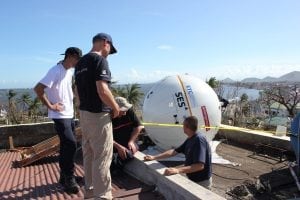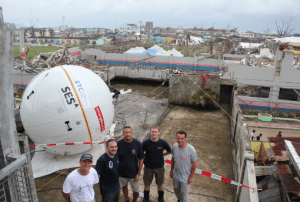Emergency.lu Team Leader Recaps Disaster Response Lessons Learned in the Philippines
[Via Satellite 1-6-2014] It has been roughly two months since Typhoon Haiyan battered the Philippine islands, causing an unprecedented level of damage. As soon as rescue efforts could begin, Luxembourg-based emergency.lu deployed personnel and equipment to restore Internet connectivity for humanitarian groups. The work done by emergency.lu helped propel disaster relief to a new level of efficiency, as the first 72 hours are critical to saving the most lives. While no two natural disasters are the same, the team that was deployed was able to learn valuable lessons from the Philippines on how to continue to improve relief efforts.
“The typhoon Haiyan response was the first deployment of emergency.lu to a sudden onset disaster offering free connectivity to all the humanitarian actors,” Gilles Hoffmann, team leader of the emergency.lu Philippine deployment, told Via Satellite. “As soon as we had fuel for our power generator, the system was built up and functional in less than two hours. We provided Internet in the City Hall and to some NGO’s having their office on the opposite side of the road. The next day we spread out the connectivity to all needed locations in Tacloban with the help of our partners from the ‘Emergency Telecommunication Cluster.’ Additional systems have been installed in Ormoc and Guian in the following days.”
Hoffmann has been deployed on previous missions with emergency.lu to reach estranged locations around the world. He has been sent twice to the Republic of South Sudan, and once to the Comoros Islands in response to flash floods. He has also been on several training exercises. These experiences helped ready Hoffmann for emergency.lu’s first response to an onset disaster.
“Roads were blocked, cars and trucks [were] unavailable and air transport [was] insufficient,” said Hoffmann, describing the situation. “With the support of our colleagues from the Logistic Cluster we were able to manage this situation. Overall coordination of all the efforts is also a big problem in the first hours and days in such an environment, as well as practical problems [such] as water and food supply to the team, sanitation, climate etc. Preparedness and training helps to address these issues.”
The satellite based infrastructure, enabled largely through SES, provided connectivity to humanitarian workers at various stages of the rescue effort. Responders were able to communicate between each other, enabling rescue teams to coordinate with the “On Site Operations and Coordination Center,” along with their own headquarters. “As of today, more than 5,300 users have registered to the “Emergency Telecommunication Cluster” network which is distributing the emergency.lu connectivity,” said Hoffmann. “This communication allows a better coordination of all the relief efforts as well as to share data assessment reports, maps, pictures, etc.”
Despite being the first unscheduled deployment, emergency.lu was still faster at setting up connectivity after Typhoon Haiyan than during previous disasters. The emergency.lu platform is not content with this however, and is looking to apply what its members have learned to future responses.
“Emergency.lu has pre-booked satellite capacity to be able to respond immediately when a disaster strikes,” said Hoffmann. “The Philippines are located on the edge of the beam causing a low elevation angle of about 13 degrees. Due to this low angle it was difficult to find spots with a clear line of sight to the satellite. Together with our partner SES we will try to find a solution for this issue.”
Ultimately emergency.lu wants to offer more than just Internet connectivity. It has several other services described as “under development” with the Emergency Telecommunication Cluster. These additional services will broaden what emergency.lu can do, and make it possible to save even more lives in the future.
“The Haiti earthquake 2010 was actually the trigger to develop the emergency.lu solution,” said Hoffmann. “One lesson learned after Haiti was that the coordination efforts were hampered due to a lack of communication in the first hours and days … during the Philippines response we offered only Internet connectivity, but we want to deploy services like voice services, tracking and tracing, mapping, file sharing, etc. in the next emergencies. The aim of emergency.lu is not to only offer connectivity but to offer services to the humanitarian actors.”

